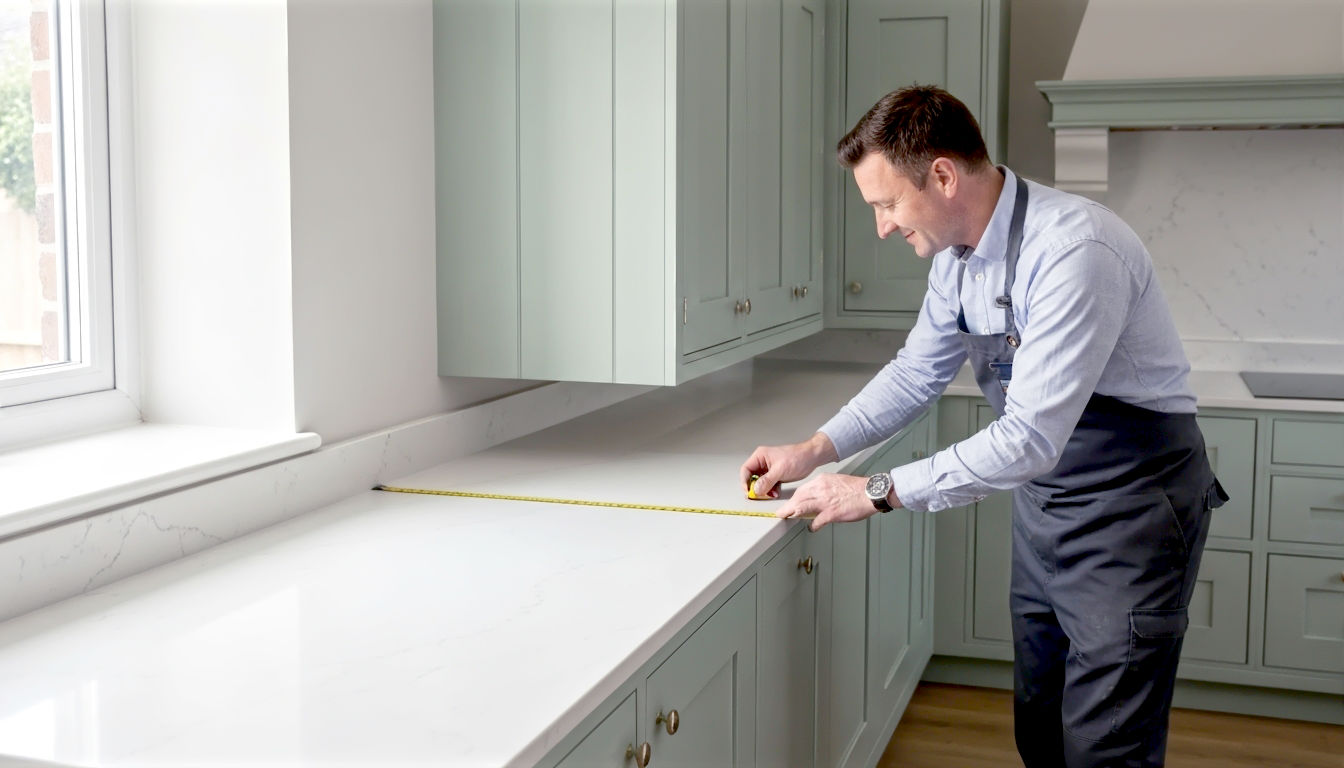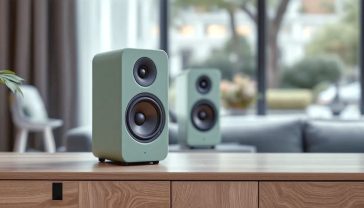The Guide to Kitchen Worktop Sizes in the UK: Are They Standard?
A complete guide to UK kitchen worktop sizes. Discover the standard dimensions for depth, length, and thickness, and see how materials like laminate, wood, and stone differ.

This post may contain affiliate links. If you make a purchase through these links, we may earn a commission at no additional cost to you.
Walk into any kitchen showroom in Britain, and you’ll be met with a dazzling array of worktops. Gleaming quartz, rustic oak, sleek laminate—the choices feel endless. But underneath all that polished stone and pristine wood lies a fundamental question that stumps many homeowners: Are kitchen worktops a standard size?
The short answer is yes… and no. It’s a bit like asking if there’s a standard size for a pair of jeans. While you’ll find common ‘off-the-peg’ sizes that fit most people, there are endless variations for different body shapes, styles, and needs.
Think of it this way: kitchen units—the cupboards and drawers that form the base of your kitchen—are highly standardised. This standardisation is the bedrock of modern kitchen design, allowing for mass production and predictable layouts. Because worktops sit on top of these units, they naturally follow a set of common dimensions. However, the final size is also shaped by the material you choose, the unique layout of your kitchen, and your personal preferences.
This guide will demystify the world of worktop dimensions. We’ll break down the standard sizes you’re likely to encounter, explore why they exist, and explain how different materials like laminate, wood, and stone can affect the final measurements. We’ll also cover those non-standard situations, from breakfast bars to custom-built kitchens, ensuring you have all the information you need to make the right choice for your home. Whether you’re planning a full renovation or just replacing an old surface, consider this your definitive handbook to getting your worktop sizes spot on.
The Foundation of Kitchen Design: Standard Unit and Worktop Depths
To understand worktop sizes, we first need to look at what’s underneath them. The dimensions of your kitchen worktop are dictated primarily by the size of the base units they rest on.
Why Standardisation Rules the Kitchen
In the UK, the kitchen industry settled on a set of standard sizes for cabinets decades ago. This was a game-changer. It meant that manufacturers could produce units in bulk, bringing costs down for everyone. It also meant that homeowners could mix and match cabinets, appliances, and worktops from different suppliers, confident they would all fit together.
This system is built around a simple principle: predictability. When a kitchen fitter arrives on site, they know that a standard 600 mm base cabinet will have a certain height and depth. This makes the entire installation process smoother, faster, and more efficient.
The Magic Numbers: Standard Cabinet and Worktop Dimensions
So, what are these crucial dimensions?
- Standard Base Unit Depth: The most common depth for a kitchen base unit in the UK is 570 mm. This measurement is taken from the front of the cabinet door to the back panel.
- Standard Worktop Depth: To fit comfortably on a 570 mm deep unit, the standard worktop depth is 600 mm. But why isn’t it 570 mm? This extra 30 mm is crucial and creates what’s known as an overhang.
Understanding the All-Important Overhang
The worktop overhang is the small lip that extends beyond the front of the cabinet doors. It’s not just for looks; it serves several practical purposes:
- Protecting Your Cabinets: The overhang directs spills—water, crumbs, and cooking splashes—away from your cabinet doors and drawer fronts. Without it, liquids would run straight down, potentially damaging the finish or even seeping into the joins. It’s a simple but brilliant piece of functional design.
- Comfort and Ergonomics: That little bit of extra space allows you to stand closer to the worktop without your feet bumping against the plinth (the kickboard at the bottom). It makes everyday tasks like chopping vegetables or washing up more comfortable.
- Hiding Imperfections: Walls are rarely perfectly straight. The overhang at the back of the worktop helps to cover any small gaps between the cabinets and the wall, creating a neater, more professional finish.
Typically, the overhang is around 20-30 mm at the front. At the back, a small gap is often left to accommodate pipes and uneven walls, which is then covered by an upstand or tiles.
While 600 mm is the most common worktop depth, you will often see depths of 620 mm, 650 mm, and even up to 900 mm for breakfast bars and island units. We’ll explore these larger sizes later on.
Worktop Sizes by Material: How Your Choice Affects Dimensions
The material you choose for your worktop doesn’t just impact the look and feel of your kitchen; it also plays a significant role in the sizes available. Manufacturers produce worktops in different materials at different standard dimensions based on production methods, raw material sizes, and transport logistics.
Let’s look at the most popular materials in the UK and their typical ‘off-the-shelf’ sizes.
Laminate Worktops: The Versatile Favourite
Laminate is the most popular worktop material in Britain, prized for its affordability, durability, and vast range of colours and finishes. Because it’s a manufactured product, it’s available in highly standardised sizes.
- Standard Lengths: The most common length for a laminate worktop is 3,000 mm (3 metres). You’ll also frequently find them in 4,100 mm (4.1 metres) lengths. These long lengths are designed to cover a good run of cabinets without needing a join, which is ideal for achieving a seamless look.
- Standard Depths: As we’ve discussed, 600 mm is the go-to depth. However, manufacturers also produce laminate worktops in wider formats for specific uses:
- 665 mm or 670 mm: Often sold as ‘breakfast bar’ worktops, these can be used on a peninsula with a small overhang for seating on one side.
- 900 mm: This is the standard depth for island units, providing a generous workspace and enough room for an overhang for seating.
- Standard Thicknesses: Laminate worktops have evolved from the chunkier profiles of the past. The most common thicknesses today are:
- 38-40 mm: This has been the industry standard for many years and remains hugely popular. It gives a solid, substantial look.
- 20-30 mm: Thinner profiles have become incredibly fashionable, offering a more contemporary, minimalist aesthetic. These slimline worktops, often with a solid-coloured core, mimic the look of more expensive materials like quartz or solid surface composites.
Key takeaway for laminate: It offers the most predictable and standardised sizes, making it a straightforward choice for most kitchen layouts.
Solid Wood Worktops: Natural Beauty, Natural Variations
Solid wood worktops bring warmth and character to a kitchen. Oak, beech, walnut, and bamboo are all popular choices in the UK. Like laminate, they are sold in standard lengths and depths, but being a natural product, there’s a bit more to consider.
- Standard Lengths: Wood worktops are commonly available in lengths of 2,000 mm, 3,000 mm, and 4,000 mm.
- Standard Depths: The depths follow the same logic as laminate, with 620 mm being a very common depth (offering a slightly more generous overhang). You will also find them in 720 mm and 960 mm for breakfast bars and islands. The slightly different numbers (e.g., 620 mm instead of 600 mm, 960 mm instead of 900 mm) often come down to the specific manufacturer and the raw timber sizes they work with.
- Standard Thicknesses: Wood worktops typically come in two main thicknesses:
- 27 mm: A slimmer and more affordable option.
- 40 mm: The classic, chunky ‘butcher’s block’ style that is very popular in traditional and country-style kitchens.
Important consideration for wood: Wood is a natural material that expands and contracts with changes in temperature and humidity. It’s crucial that an expansion gap is left where the worktop meets the wall to allow for this movement. This is usually hidden by an upstand.
Stone and Quartz Worktops: The Bespoke Approach
This is where the idea of ‘standard sizes’ really starts to change. Materials like granite, marble (natural stone), and quartz (an engineered stone composite) are almost always sold on a template-and-fit basis.
You don’t buy a 3-metre slab of granite from a DIY store. Instead, a specialist company will come to your home after your base units are installed. They will create a precise template of your kitchen, often using laser measuring equipment. This template is then taken back to their workshop, where they cut your worktop from a massive slab of stone to your exact requirements.
- Slab Sizes, Not Worktop Sizes: The key measurement here is the ‘jumbo slab’ size from which your worktop is cut. For quartz, a typical jumbo slab might be around 3,200 mm x 1,600 mm. For natural granite, sizes vary more depending on how the stone was quarried.
- Why Template-and-Fit is Essential:
- Weight: Stone is incredibly heavy. A 3-metre slab would be impossible for a DIYer to handle and install safely.
- Cutting: It requires specialised diamond-bladed saws and water jets to cut precisely.
- Joins: Creating neat, inconspicuous joins (seams) in stone is a skilled job that needs to be done by professionals.
- Cut-outs: Cut-outs for sinks and hobs need to be perfectly measured and polished.
- Thicknesses: Stone and quartz worktops are typically available in:
- 20 mm: A popular choice for modern, sleek kitchens.
- 30 mm: The traditional thickness, offering a robust and luxurious feel.
Key takeaway for stone/quartz: Forget standard lengths and depths. The only thing that matters is the final, custom-fit size created specifically for your kitchen.
Solid Surface Worktops (e.g., Corian): Seamlessly Custom
Solid surface worktops are made from a blend of acrylic resins, minerals, and pigments. They are prized for their ability to be joined almost invisibly, creating a completely seamless surface.
Like stone, solid surface worktops are almost always installed by specialist fabricators. They are supplied in large sheets, which are then cut, shaped, and bonded together on-site to perfectly fit your kitchen layout. This means you can have curves, integrated sinks, and drainer grooves for a truly bespoke finish.
- Standard Sizes: Standard sizes are less relevant to the homeowner and more to the fabricator. The focus is entirely on the finished, custom dimensions.
- Thicknesses: While the worktop might look chunky, the material itself is often thinner (e.g., 12 mm) and bonded to a moisture-resistant chipboard substrate to build it up to the desired thickness, typically around 38-40 mm.
Beyond the Basics: Deeper Worktops, Islands, and Breakfast Bars
While a 600 mm deep worktop is the standard for a run of cabinets against a wall, modern kitchen design has embraced larger and more varied surfaces.
Deeper Worktops for More Space
Sometimes, a standard 600 mm depth just isn’t enough. You might opt for a deeper worktop for several reasons:
- Accommodating Pipework: In older properties, thick pipes or a boxed-in soil pipe might run behind the kitchen units. A deeper worktop (e.g., 650 mm or 700 mm) can be used to cover this void without you having to move the cabinets forward.
- Space for Appliances: If you have large appliances on your worktop, like a coffee machine or a stand mixer, a bit of extra depth gives you more usable prep space in front of them.
- Fitting Larger Hobs: Some range cookers or large induction hobs require a deeper worktop to fit safely. Always check the manufacturer’s installation guide for the specific requirements.
Kitchen Islands: The Hub of the Home
A kitchen island is a freestanding unit that has become a must-have feature in many British homes. Its worktop dimensions are designed to be both functional and sociable.
- Standard Island Depth: The most common depth for an island worktop is 900 mm. This provides a good amount of workspace. However, if you want to include seating, you’ll need to go wider.
- Island Depth with Seating: For comfortable seating at an island, you need a sufficient overhang for people’s knees.
- A 900 mm deep worktop can accommodate a small breakfast bar if the base units are narrow (e.g., 300-400 mm deep).
- A 1,200 mm deep worktop is ideal. This allows for a standard 600 mm deep cabinet on one side, a back panel, and a generous overhang of around 300-400 mm for bar stools.
- Island Length: The length of an island worktop depends entirely on the size of your kitchen. It can range from a compact 1,200 mm to a grand 3,000 mm or more. The limiting factor is often the slab size of your chosen material if you want to avoid joins.
Breakfast Bars and Peninsulas
A breakfast bar is a worktop that extends from a wall or a run of units, creating a casual dining spot. A peninsula is similar but has units underneath.
- Standard Breakfast Bar Depth: A worktop specifically designed for a breakfast bar is typically 900 mm deep. This allows it to be fixed to the wall and still have plenty of overhang for seating.
- Overhang is Key: The golden rule for comfortable seating is an overhang of at least 300 mm. This gives enough legroom without people feeling cramped.
Practical Considerations: Height, Thickness, and Installation
Getting the size right isn’t just about length and depth. You also need to think about the height and thickness of your worktop.
Standard Worktop Height: The Ergonomic Standard
The finished height of your kitchen worktop is one of the most important ergonomic measurements in your home. Too low, and you’ll be stooping. Too high, and it will be uncomfortable to work at.
- The UK Standard: The standard finished height for a kitchen worktop in the UK is 900 mm from the floor.
- How it’s Calculated: This height is achieved through a simple formula:
- Kitchen Plinth Height: ~150 mm
- Base Cabinet Height: ~720 mm
- Worktop Thickness: ~30-40 mm
- Total: ~900-910 mm
This height has been found to be a comfortable average for most people. However, if you are particularly tall or short, you might consider a custom height. This can be achieved by ordering bespoke cabinets or adjusting the height of the plinth.
Worktop Thickness: More Than Just an Aesthetic Choice
As we’ve seen, worktop thicknesses vary by material, from slimline 20 mm profiles to chunky 40 mm wood blocks. Your choice will be driven by aesthetics, but there are practical points to consider:
- Hob Installation: Some hobs, particularly sleek induction models, have specific requirements for the minimum worktop thickness they can be installed in. A 20 mm quartz worktop might be too thin for certain models without extra support. Always check the hob’s technical specifications.
- Weight and Support: A thicker worktop is a heavier worktop. Your kitchen cabinets are more than capable of supporting a standard 30 mm or 40 mm worktop, but if you were considering an extra-thick concrete or granite top, you would need to ensure your units are strong enough to bear the load.
- Visual Balance: The thickness of your worktop should be in proportion to the rest of your kitchen. A very thick, chunky worktop might overwhelm a small kitchen with minimalist, handleless doors. Conversely, a super-slim worktop might look lost in a large, traditional kitchen with ornate shaker-style cabinets.
Conclusion: Standardisation is the Starting Point, Not the Final Word
So, are kitchen worktops a standard size? The answer is a resounding “it depends.”
There is absolutely a set of standard dimensions that form the backbone of the UK kitchen industry. A depth of 600 mm, lengths of 3 metres, and a finished height of 900 mm are the numbers you will see time and time again. This standardisation is what makes buying and fitting a kitchen a predictable and affordable process. It ensures that cabinets from one company will fit with worktops from another and that your oven will slide perfectly into its housing.
However, these standards are merely the starting point. The final size of your worktop will be tailored to the unique layout of your room, the specific requirements of your chosen material, and your vision for how you want to use the space.
- If you choose laminate or solid wood, you will be working with standard ‘off-the-shelf’ lengths and depths that are cut to size during installation.
- If you opt for stone, quartz, or solid surface, the concept of standard sizes disappears, replaced by a bespoke template-and-fit service that creates a worktop measured to the millimetre for your home.
- If you dream of a large kitchen island or a breakfast bar, you will be moving beyond the standard 600 mm depth to create multifunctional surfaces designed for modern living.
Ultimately, the best approach is to think of standard sizes as a helpful guide. They provide the framework, but you have the freedom to adapt them. By understanding the common dimensions and the reasons behind them, you are empowered to plan your kitchen with confidence, knowing that your final worktop will be the perfect fit in every sense of the word.
Further Reading
For those looking to delve deeper into kitchen design and materials, these resources are highly recommended:
- Wren Kitchens – Worktop Buying Guide: A comprehensive overview of different worktop materials and their characteristics.
- Magnet Kitchens – Kitchen Worktop Planner: An interactive tool and guide to help you choose the right worktop for your style and budget.
- Howdens – Kitchen Worktop Advice: Professional advice on selecting, fitting, and caring for various types of worktops.
- The Royal Institute of British Architects (RIBA) – Find an Architect: For those planning a major renovation, RIBA offers a directory of certified architects who can provide expert design guidance.






